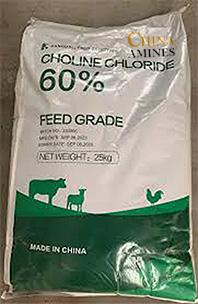1. Chemical Structure and Properties
Active Component: Choline Chloride (C₅H₁₄ClNO)
Structural Formula: [HOCH₂CH₂N⁺(CH₃)₃]Cl⁻ – a quaternary ammonium salt with hydroxyl and trimethylammonium groups
Carrier Material: Processed Corn Cob (cellulose, hemicellulose, lignin)
Composition: 60% choline chloride adsorbed onto 40% corn cob granules
Physical Properties:
Appearance: Light tan to brown granular solid with a mild, earthy odor
Particle Size: 1–3 mm; Bulk Density: ~0.6–0.7 g/cm³
Moisture Content: <6% (w/w); corn cob reduces hygroscopicity compared to pure choline chloride
Solubility: Choline chloride dissolves in water; corn cob is insoluble but swells in moisture
Key Features:
- Excellent flowability; dust-free handling
- Corn cob enhances shelf stability in humid storage environments
2. Industrial Applications
Animal Feed Additive:
- Primary Use: Prevents fatty liver syndrome and promotes efficient growth in poultry and swine
- Dosage: 600–1,200 g/ton feed (NRC guideline)
- Mode of Action: Enhances methionine metabolism and lipid transport via methyl donation
Agriculture:
- Foliar Application: 0.3–0.5% aqueous solution improves drought resistance and nutrient uptake in maize, soybean, etc.
Advantages Over Other Carriers:
- Renewable and biodegradable
- Lower cost and carbon footprint vs. silica or synthetic carriers
3. Safety and Toxicology
Choline Chloride:
- Oral Toxicity: Low (LD50 rat: >5,000 mg/kg); considered practically non-toxic
- Skin/Eye Contact: Mild irritation potential; low dermal toxicity (LD50 >2,000 mg/kg)
- Inhalation Risk: Minimal due to dust-free formulation
Corn Cob Carrier:
- GRAS-listed (FDA 21 CFR 582.99); non-toxic and non-allergenic
- OSHA PEL for inert dust: 15 mg/m³ – low airborne particulates due to granular form
Handling Precautions:
- Use nitrile gloves and goggles for bulk operations
- Store in dry, cool area to prevent clumping
4. Environmental and Regulatory Compliance
Environmental Impact:
- 100% biodegradable carrier; supports circular economy by upcycling agri-waste
- Choline chloride readily degrades into betaine and harmless metabolites
- Aquatic Toxicity: LC50 (fish, 96h): >100 mg/L (OECD 301F)
Regulatory Compliance:
- China: GB/T 23735–2021 certified
- USA: FDA GRAS (21 CFR 582.5250); AAFCO-compliant
- EU: Feed additive approved for poultry/swine (EC 1831/2003, E 3.1.1)
- REACH: Corn cob exempt from SVHC listing due to natural origin
5. Case Studies and Application Insights
Case 1: Broiler Production in India (2023)
- Application: 800 g/ton feed of 60% corn cob choline chloride
- Outcome: 18% reduction in liver fat; 6.5% FCR improvement vs. control
- Cost Benefit: $0.75/ton feed savings vs. silica-based formulations
Case 2: Sustainable Swine Farming in Germany (2022)
- Application: Switched from synthetic to corn cob carriers in weaner diets
- Results: 15% reduction in diarrhea; 8% increase in average daily gain (ADG)
Comparative Analysis:
- Pros: Biodegradable, low-cost, renewable resource, and improved palatability
- Cons: Slightly less moisture resistance vs. silica under prolonged humid storage


